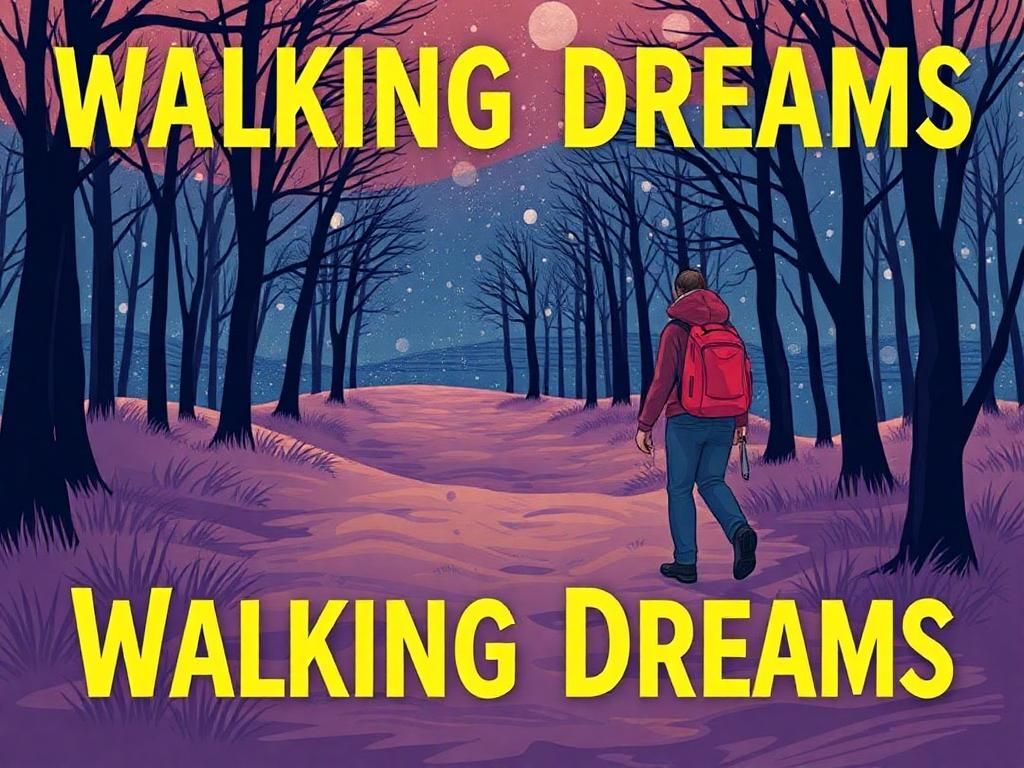Walking dreams offer a fascinating glimpse into the inner workings of our subconscious minds while we are asleep. They represent a unique category of dreams that are distinct from lucid dreams, nightmares, and other sleep phenomena. Unlike lucid dreams, where we are aware that we are dreaming and can often control the narrative, walking dreams often evoke a strong sense of exploration and a journey through various landscapes—both familiar and unfamiliar. This phenomenon has intrigued dreamers and psychologists alike, leading to a wealth of interpretations and insights into our psyche.
Introduction to Walking Dreams
Definition of Walking Dreams
A walking dream can be described as a dream in which the individual finds themselves walking or moving through different terrains—often reflective of their personal experiences or emotional states. This type of dream typically emphasizes freedom, exploration, and a journey of self-discovery. In contrast, nightmares usually evoke fear and anxiety, whereas lucid dreams involve awareness and control over the dream environment.
History of Dream Interpretation
Throughout history, dreams have held profound significance in various cultures. Ancient Greeks and Egyptians viewed dreams as omens or messages from the divine. In Greek mythology, Hypnos, the god of sleep, was believed to send dreams as a means of communication. Modern psychology offers another perspective, positing that dreams—including walking dreams—are reflections of our subconscious mind, revealing our hidden desires, fears, and thoughts.
The Science Behind Dreams
Sleep Cycles and REM Sleep
Understanding the science behind dreams requires an exploration of sleep cycles, particularly the role of REM (Rapid Eye Movement) sleep. Each night, we cycle through different stages of sleep, with REM sleep typically occurring about 90 minutes after falling asleep. During this stage, brain activity increases significantly, allowing for vivid dreaming. The longer we sleep, the more REM cycles we experience, thereby increasing our chances of having walking dreams.
Neurological Aspects
The brain plays a critical role in dreaming, with various areas activating during REM sleep. The prefrontal cortex, often associated with rational thinking, is less active during dreams, allowing for the often illogical events that occur in dreams. Neurotransmitters such as serotonin and dopamine are also believed to influence the dream experience, contributing to the emotional tone of walking dreams and other dream types.
Symbolism and Meaning of Walking Dreams
Common Themes in Walking Dreams
Walking dreams often symbolize life’s journey, manifesting as feelings of freedom or exploration. The setting can also reveal personal insights—the act of walking can represent moving forward in life, embarking on new paths, or the quest for personal growth.
Common interpretations include:
– **Freedom**: Walking as a method of liberation.
– **Journey**: Reflective of life’s ups and downs.
– **Exploration**: A drive to discover new facets of oneself.
Cultural Interpretations
Across various cultures, walking dreams hold different meanings. In some indigenous cultures, walking in dreams is seen as a spiritual journey, where dreamers connect with their ancestors or nature. In folklore, certain myths describe walking dreams as journeys into the spirit world, emphasizing transformation and enlightenment.
Psychological Implications of Walking Dreams

Insight into One’s Psyche
Walking dreams can reveal deep insights into an individual’s psyche. They often reflect personal thoughts, feelings, and real-world experiences. For instance, dreaming of walking through a forest may signify the dreamer’s desire for solitude or contemplation, while traversing a bustling city might denote anxiety or a need for social connection.
Therapeutic Aspects
Many therapists utilize walking dreams in dream analysis, interpreting them to aid clients in better understanding their thoughts and feelings. Discussing these dreams can foster emotional clarity, ultimately leading to improved mental well-being.
How to Enhance Dream Recall and Awareness
Techniques for Better Dream Recall
To fully benefit from walking dreams, one must cultivate good dream recall:
1. **Keeping a Dream Journal**: Recording dreams immediately upon waking helps solidify details and themes.
2. **Setting Intentions Before Sleep**: By focusing on desired outcomes or questions before sleep, dreamers can better guide their dreaming experience.
Practicing Lucid Dreaming
Lucid dreaming allows individuals to become aware during their dreams and exert some control over the narrative. Techniques include performing reality checks throughout the day and repeating affirmations before sleep to increase the likelihood of achieving lucidity.
Tips for Navigating Walking Dreams
Strategies for Positive Dream Experiences
To ensure a more positive dream experience, consider:
– **Fostering a Peaceful Sleep Environment**: Creating a calming atmosphere with low lighting, soothing sounds, and comfortable bedding can significantly improve sleep quality.
– **Visualization Techniques Before Sleep**: Imagining peaceful scenes or envisioning desired dream scenarios can provide a sense of tranquility, aiding in better dream experiences.
Dealing with Nightmares or Disturbing Dreams
While walking dreams can be enlightening, they can sometimes lead to nightmares or disturbing experiences. Approaches to confront fear within dreams include:
– **Mindfulness and Grounding Techniques**: Practicing mindfulness can help dreamers gain control, allowing them to confront fears within the dream.
– **Cognitive-Behavioral Techniques**: Rethinking the narrative of a nightmare can transform it into a more positive experience.
Personal Accounts and Anecdotes
Real-Life Stories of Walking Dreams
Sharing personal experiences can illuminate the diverse meanings found in walking dreams. Many individuals recount feeling empowered during these dreams, often emerging with a renewed sense of purpose. This collection of accounts highlights common themes and reveals varied interpretations across different backgrounds.
Interpretation of Specific Walking Dream Scenarios
Through the lens of specific scenarios, walking dreams can take on distinct meanings. For instance:
– **Walking Through a Forest**: May symbolize a quest for inner peace or solitude.
– **Climbing a Mountain**: Often represents overcoming challenges and achieving personal goals.

Conclusion
Summary of Key Points
The significance of walking dreams lies in their ability to provide personal insights and reflections on our emotional states. By exploring the themes, cultural meanings, and psychological implications of these dreams, one can gain a richer understanding of their subconscious mind.
Final Thoughts
As we explore our dreams, we uncover layers of our consciousness longing for expression. An invitation is extended to all readers to share their own walking dreams and interpretations. Open the door to self-discovery by delving into the world of dreams.
| Aspect | Description |
|---|---|
| Definition | Walking dreams involve the act of walking or journeying in a dream, reflecting personal emotions and experiences. |
| Themes | Common themes include freedom, exploration, and personal growth. |
| Interpretation | Cultural perspectives offer diverse meanings, linking walking dreams to spiritual journeys and personal revelations. |
| Advice | Techniques for enhancing dream recall include keeping a dream journal and practicing visualization. |
| Psychological Insight | Walking dreams often reflect the dreamer’s subconscious thoughts, desires, and fears. |
Frequently Asked Questions (FAQs)
1. What are walking dreams?
Walking dreams are dreams in which the dreamer experiences walking, often representing a journey of personal growth or exploration.
2. How can I recall my walking dreams?
Keeping a dream journal and setting intentions before sleep can enhance dream recall.
3. Are walking dreams the same as lucid dreams?
No, walking dreams do not typically involve awareness or control like lucid dreams do.
4. What do walking dreams symbolize?
They often symbolize freedom, exploration, and the journey of life.
5. Can walking dreams reflect my real-life experiences?
Yes, they often mirror personal thoughts, emotions, and experiences.
6. How can I deal with nightmares from walking dreams?
Mindfulness techniques and cognitive reframing can help confront fears in nightmares.
7. What role does REM sleep play in dreaming?
REM sleep is crucial for vivid dreaming; it allows for increased brain activity and emotional processing.
8. How are cultural interpretations of walking dreams different?
Different cultures perceive walking dreams as spiritual journeys or connections with ancestral spirits.
9. Do walking dreams have therapeutic applications?
Yes, they can be analyzed in therapy to gain insights into the individual’s psyche.
10. Can practicing lucid dreaming help with walking dreams?
Yes, lucid dreaming can enhance awareness and control, providing further exploration of walking dreams.
